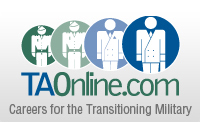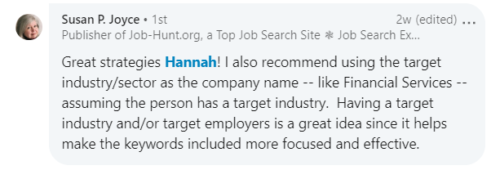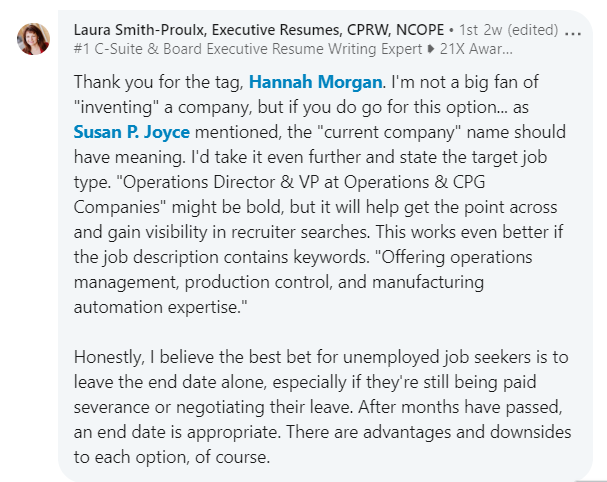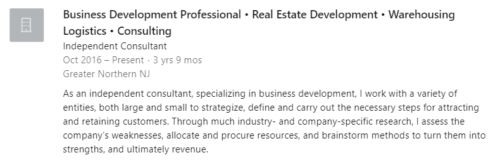|
Sponsored By: |
Transition Insight
"" |
 |
|
Featured Employers |
||||
Featured Jobs
Operations Scheduler - Performance Health - Greenwood - AR
National Accounts Manager, LTC - Performance Health - Akron - OH Funeral Director/Embalmer - Park Lawn Corporation - NC Service Manager - CertaSite - Kent - OH Maintenance Supervisor - Bimbo Bakeries USA - Fergus Falls - MN |
|||||
TAOnline Partners |
TAOnline Career Corner |
FREE U.S. Veterans Magazine Subscription for TAOnline Members!U.S. Veterans Magazine (USVM) Is the premiere resource magazine for transitioning service members, service-disabled veterans, veteran business owners and their spouses and families. USVM is the link between the qualified students, career and business candidates from the ranks of our nation's veteran organizations, educational institutions, corporate America, and the federal government. |
Networking Email Templates for Job Seekers During A PandemicBy Hannah Morgan | Career Sherpa - ©2020 Reprinted with permission Getting a response to a networking email can be difficult, especially during a pandemic. These networking three email templates were designed to make it easier for you to craft your message and get a response. The best time to network is BEFORE a job is posted. You're more likely to get a response to your request because employees aren't involved in the hiring process yet. This is even true during a pandemic. You'll find three networking email templates:
The Purpose of NetworkingYour primary purpose in networking is to get AIR (advice, information or recommendations) from someone who works inside a company or has expertise in an industry or role you are interested in. Secondarily, you are building a relationship with someone who may keep you in mind when they hear about job opportunities in the future. Read more about why networking isn't a waste of time and how to do it right. Here's an example of how NOT to ask for a favor from someone. Networking During A PandemicNow is a perfect time to network with people. Keep in mind, the majority of the workforce is still working — and most of them are working remotely. If people are working remotely, they most likely have more flexibility in their schedule to talk with people. And because they don't need to worry about their boss or co-worker listening in. The Coronavirus also is a great excuse to reach out to people you haven't talked with to see how they are doing. If you discover they are out of work, then you can share your resources and perhaps team up as accountability partners. Don't assume that people are too busy, overwhelmed, unemployed, or don't want to talk with you. You may find exactly the opposite. Types of People You'll Network WithHere's a list of 10 types of people you should network with during your job search. And what you'll notice is that these are ALL people you know! Always, always, always focus networking on the people you know before reaching out to strangers!
Basic Networking Email Rules
What To Include In Your EmailHere's what your networking email message should include:
Networking Email Template #1: Request for Informational MeetingReaching out to people you know and asking for a quick conversation is the best way to refine your networking skills AND get the word out that you are looking for a new role. Hello [Name], I hope you are doing well and staying safe [all is well in with you during these unusual times]. I'm reaching out because I [was recently laid off due to coronavirus-related cutbacks at Z company / am looking for my next opportunity / (or state your reason)] and I hope you might be able to help. I'm looking for a position in [the industry they work in / as a job they have or had] and [I know you have experience in this area (or the reason you are asking for an informational meeting)]. Would you be available to talk briefly over the phone or video? I'd appreciate just 15 minutes of your time. Your insight and advice in these areas would be extremely valuable: [your experiences working in X role / your perspective on valuable skills and training in X role / what it's like to work at Z company / how to break into the industry]. Thank you in advance for any help you can provide. I look forward to catching up. Name Email signature block (phone number, occupation or tagline, LinkedIn URL, email address) Networking Email Template 2: Asking A Contact to Make an IntroductionKeep in mind, you want to make it easy for someone to facilitate and introduction. In fact, you want to make your message to your contact easy to forward along. Hi [Name], How are you doing during these unusual times? I hope all is well. I'm reaching out today with a request. Unfortunately, [I was recently laid off due to the Coronavirus/I find myself searching for a new opportunity]. I noticed that you are connected to [Name] on LinkedIn, and I was hoping that you'd be willing to introduce us. I'd love to connect with [Name] and ask a few questions about [the industry / their company] and [his/her] experience. Would you be willing to introduce us through email? I'd really appreciate that. After X years with Z company, I am looking for a new job [in X industry as a Y position]. My experience includes [2-3 work related skills, processes or procedures, or projects] and I am interested to learn how these might fit with Z company. Thank you in advance for your help! Please let me know if you have any questions and if there's anything that I can do to help you. Name Email signature block (phone number, occupation or tagline, LinkedIn URL, email address) Networking Email Template 3: Opening At Company Where You Know SomeoneHere's a template to help make it easier to ask (and get) a referral when you know someone inside a company with an opening. Hello [name of connection]: I wanted to reach out and ask for your help. There's a job for a [job title] with your company and I'm very interested in applying for it. You may remember, [state how you know each other]. I have been watching [company] and am excited about [something interesting the company is working on]. Additionally, [company]'s focus on [volunteer projects the company supports] aligns well with the volunteer work I've been doing at [volunteer organization] (or state another reason you match the company). Based on what I read, I believe I would be a great fit for the role.
Any insight or help you can offer is greatly appreciated. Please advise on how I should best proceed. If you need more information I'm happy to have a conversation if that would be easier. Thank you in advance for your help and support! Name Email signature block (phone number, occupation or tagline, LinkedIn URL, email address) Adapt As NecessaryEach situation is unique, so please be sure to modify these networking email templates to suit your needs. |
Federal teachers union urges military parents to choose DODEA’s online learning optionBy CAITLIN DOORNBOS | Stars and Stripes - Reprinted with permission, ©2020 All Rights Reserved Stars and Stripes is making stories on the coronavirus pandemic available free of charge. See other free reports here. Sign up for our daily coronavirus newsletter here. Please support our journalism with a subscription. The Federal Education Association is urging parents of students at Defense Department schools to select the online learning option for their children as the new school year approaches. Department of Defense Education Activity parents have until Tuesday to choose whether they will keep their children at home for online learning or send them back to school for classroom instruction this fall as the coronavirus pandemic rages on. The teachers' union "believes preparations and precautions are not adequate to safely reopen schools for in-person learning given current conditions in many locations," spokesman Gary Hritz said in a statement sent to Stars and Stripes on Monday. The association has advocated for online-only instruction this fall and is now turning to parents directly to select the virtual learning option "as a way to protect against contracting and spreading the virus within the military community," according to the statement. DODEA schools closed this spring in favor of online instruction as the coronavirus spread across the world. Schools in Italy shut their doors on Feb. 24, followed by Bahrain and South Korea two days later. Those in Germany, Belgium, the Netherlands, Turkey, Spain, Japan and the United Kingdom closed in March. Next month, DODEA plans to reopen schools in areas where the Health Protection Condition Bravo or better while offering a virtual option for students whose parents choose to keep them at home. Condition Bravo indicates the risk level is moderate with an increased chance of community transmission, according to the Defense Department. Some parents, such as DODEA substitute teacher Samantha Valera, are grateful for the chance to send their children back for classroom schooling. "I think if it wasn't something they could do safely, they wouldn't do it," said Valera, who will send her third-grader to classrooms at Sullivans Elementary School on Yokosuka Naval Base. "I'm glad they will be having both options for parents to choose for their children, but I hope teachers are given the same option for themselves." A 20-page document outlining how DODEA will implement social distancing in classrooms includes a number of protocols, including separating desks by six feet "where possible" and increasing the frequency of handwashing throughout the school day. The guidance also calls on school staff to "clean and disinfect surfaces" between classes, at lunch and after school. Custodians will perform "some cleaning and disinfecting," according to the document, but the rest will be the responsibility of teachers and other faculty. DODEA will not require face masks when social distancing is possible, but educators should "encourage the proper use, removal and washing of face coverings," according to the document. In the Federal Education Association statement, president Brian Chance called DODEA's precautions "completely unrealistic." "DODEA expects teachers to somehow clean every surface within a classroom while simultaneously educating children," he said in the statement. "DODEAis refusing to require students to wear masks and is instead expecting children as young as five to remain seated and a safe distance from each other throughout the day." "How can a teacher safely interact with a child if that child is not wearing a mask?" he added. Jane Loggins, the teachers' union director for domestic dependent elementary and secondary schools, in the statement called the plan to reopen Defense Department schools "a disaster waiting to happen." "The lives of DoDEA students and employees must not be put at risk by physically opening schools at this time," Loggins said. Parents can find the form to enroll in virtual school by logging in to their student's DODEA student Google account or by calling their child's school, according to the DODEA website. DODEA public affairs officials in Washington, D.C., could not be reached for comment Monday in Japan due to time zone differences. |
VA opposes bill to grant dental care to all veteransBy Nikki Wentling | Stars and Stripes - Reprinted with permission ©2020 All Rights Reserved WASHINGTON — The Department of Veterans Affairs voiced its opposition Thursday to legislation that would require the department to provide dental treatment for all veterans enrolled in VA health care. The bill, introduced by Rep. Julia Brownley, D-Calif., aims to phase in dental care at the VA within four years. Now, the department provides dental treatment only to veterans whose dental issues are related to their military service. Brownley said that is equal to about one in 17 VA enrollees being eligible for dental care. "Current law restricts the VA's ability to provide dental care to most veterans", Brownley said. "The cost of private-sector dental care is often too expensive, leaving too many veterans without dental care at all." The House Committee on Veterans' Affairs considered the bill during a hearing Thursday. The VA was strongly opposed. "We don't have the resources from a capacity perspective, and we don't have the resources from a funding perspective," said Maria Llorente, an assistant deputy undersecretary of the VA. About 9.3 million veterans are enrolled in VA health care. Of those, 1.35 million are eligible for dental care through the department. The legislation would increase the number of eligible veterans by more than 670%, Llorente said, and "create a significant spike in the need for resources to meet the increased demand". If Congress approves the bill, Llorente estimated the cost of expanding dental care would be about $7 billion the first year after the legislation is enacted. The measure would increase costs by more than $150 billion for 10 years. In response, Brownley cited a 2019 report, in which the VA said "poor oral health can have a significant negative effect on overall health." She argued providing dental care for veterans would lead to better health outcomes and lower costs in the long term. In a statement after the hearing, Brownley called the VA's opposition "baffling and disappointing". "When we send our young men and women to war, we rarely ask how we are going to pay for it, so it is frustrating to me that when they come home, we constantly hear the refrain that veterans' health care costs too much", she said. It was unclear Thursday when the committee would vote on the legislation. If passed by the committee, the bill would be sent to the House floor for consideration. |
3 Options To Update Your LinkedIn Job Title and Employer When UnemployedBy Hannah Morgan - careersherpa.net - Reprinted with Permission There are several options for listing your LinkedIn job title and employer when unemployed. Your goal is to highlight your qualifications without drawing attention to the fact that you aren't working. If you've recently been laid off, what do you do to your LinkedIn profile? There are several options for how to list your current LinkedIn job title and employer when unemployed. Why It MattersYou want to maximize the "findability" of your LinkedIn profile. And without a current job listed, you're profile is not reaching LinkedIn's All Star rating. Not listing a current job can negatively impact how your profile is ranked in search results within LinkedIn. But even more importantly, if you don't list a current job, everyone knows you are not working. And that raises more questions. (Sadly, there is still a negative bias against the unemployed.) Recruiters using LinkedIn's recruiting tools to search for candidates won't be impacted by LinkedIn's algorithm. However, a recruiter will question why you left your last job instead of focusing on your qualifications. Luckily, there are several work arounds for savvy job seekers. Here they are. Option 1: DO NOT change the end dateAfter you've been laid off, do not change your current employer end date to reflect the position ended. At least for several months. (There's no hard and fast rule on how long you can ethically get away with not changing the end date.) By all means, select that you are open to new opportunities so anyone looking at your profile can see this.
To learn more about turning on LinkedIn's "Open Candidate" feature, read this by LinkedIn. Here's my logic: First, by not changing it, you won't have to worry about how to invent a new job title and employer to show you are open to new opportunities or are in transition. Second, you won't have to enter into the line of questioning about "what have you been doing since your last job ended or why did you leave your last job?" Yes, you'll have to explain that you are no longer working for that employer, but that's a much stronger position to be in. Third, three months is an easily explainable grace period for not updating your end date. (The same rule of thumb can be true on your resume as well.) So what if it's been longer than three months? What do you use for your LinkedIn title and company when listing your current employer? Here is are two options: Option 2: Keyword Optimize the Title and Employer FieldsSo let's say it's been longer than three months or maybe you already changed your title and employer. You really need to add a new job so that you maintain your All Star standing on LinkedIn. This helps non-recruiters find you. In other words, someone without LinkedIn's recruiting tools. So what information do you use? Job TitleUse a variety of job titles you are interested in. For example, if you are looking for a role in Operations, your job title may include some of the most popular job titles you've seen, such as Operations Manager, Director of Operations, Operations Supervisor. If you have a specialty or area of operations management you excel at, you can add that too. The more descriptive your job title, the better. (Keep this logic in mind when listing ALL your job titles on LinkedIn.) Director of Business Development | New Division Launch | Change Management | Organizational Strategies Read more about crafting job titles and headlines on LinkedIn. EmployerYou can't leave the employer line blank. But you don't have an employer (yet). What do you list? And whatever you list will not have a company logo. But that's ok. It's clear that you aren't affiliated with an employer as you list the information this way. Use the industry sector to describe the type of company you would LIKE to work for. (I don't think you need to worry about using a real company name. Instead, you'll see LinkedIn's grey company logo. It really isn't all that important.) For more details about what to put in your profile when you're unemployed, read this article on The Balance Careers. Experts Weigh InThere are many LinkedIn experts who offer advice on what to put for your job title and employer when unemployed. Brenda Meller asked what title and company to list in this post on LinkedIn and it generated a helpful discussion. Always look at the logic or reason they give for sharing their recommendations.
Option 3: Use Volunteer Work or A Special ProjectIf you don't want to use option 2, and you have legitimately taken on a special project or volunteer work that aligns well with what you want to do next, you can list that instead, even if you aren't getting paid. Here's an example of an independent consultant role added on LinkedIn.
Job TitleUse a real job title and follow the recommendations for optimizing keywords offered above. If it is volunteer work, you do not need to confess that in the title. Use a job title that describes the work you are doing. For example, if you are coordinating the shifts of volunteers and training them your job title might be Coordinator | Scheduling and Training Supervisor | Non-Profit Management EmployerIf you are volunteering, use the name of the non-profit or organization. If you have taken on a special project, use the name of the business or organization you are doing work for. Add A DisclaimerYou may want to include in the description that you serve as a volunteer. You just don't want to include it in the job title. (Doing so may result in some people perceiving your work as less formal or less important.) |
|
TAOnline.com | 51 Mill Street | Bldg E Suite 21 | Hanover, MA 02339 TAO Privacy Statement | View Previous Issues | Military Job Fairs ©TAOnline.com 1996-2026, All rights reserved. |





